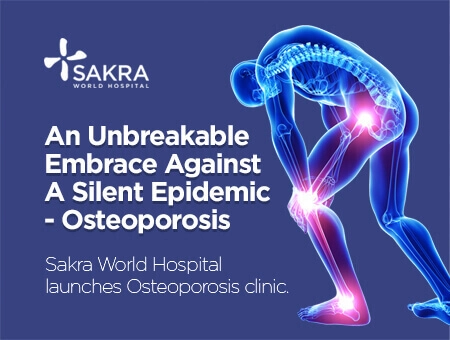Home/Wellness Zone/Sakra Blogs
2nd Sep, 2014

Osteoporosis is estimated to affect 200 million women worldwide - approximately one-tenth of women aged 60, one-fifth of women aged 70, two-fifths of women aged 80 and two-thirds of women aged 90.Worldwide, osteoporosis causes more than 8.9 million fractures annually, resulting in an osteoporotic fracture every 3 seconds. Overall, 61% of osteoporotic fractures occur in women, with a female-to-male ratio of 1.6. Nearly 75% of hip, spine and distal forearm fractures occur among patients 65 years old or over. A 10% loss of bone mass in the vertebrae can double the risk of vertebral fractures, and similarly, a 10% loss of bone mass in the hip can result in a 2.5 times greater risk of hip fracture. In India: Expert groups peg the number of osteoporosis patients at approximately 26 million (2003 figures) with the numbers projected to increase to 36 million by 2013.In a study among Indian women aged 30-60 years from low income groups, BMD at all the skeletal sites were much lower than values reported from developed countries, with a high prevalence of osteopenia (52%) and osteoporosis (29%) thought to be due to inadequate nutrition. It is projected that more than about 50% of all osteoporotic hip fractures will occur in Asia by the year 2050.
As osteoporosis has no obvious symptoms. Traditional X-rays can’t measure bone density, but they can identify spine fractures. Bone mineral density (BMD) has to be measured by more specialised techniques. A number of different types of BMD tests are available, but the most commonly used is DXA (dual-energy X-ray absorptiometry), capable of detecting quite small percentages of bone loss. It is used to measure spine and hip bone density, and can also measure bone density of the whole skeleton. While most limb fractures (such as at the wrist or hip) are obvious, spinal fractures can be more difficult to diagnose. This is because they might be painless, or if there is pain, a person may not know it is caused by a fracture due to the many different causes of back pain. More obvious signs of spinal fractures are:
Loss of height
Development of a curved upper back (sometimes called a Dowager's Hump)
Since there are usually no outward signs of osteoporosis developing, doctors will often recommend diagnostic testing depending on your age and if you have other risk factors for the disease.
Prevention: Calcium and vitamin D supplementation reduces rates of bone loss and also fracture rates in older male and female adults, and the elderly. Ensure a nutritious diet and adequate calcium intake, Avoid under-nutrition, particularly the effects of severe weight-loss diets and eating disorders, Maintain an adequate supply of vitamin D, Participate in regular weight-bearing activity, Avoid smoking and second-hand smoking, Avoid heavy drinking.
We in Sakra have started an “Osteoporosis Clinic” the first of its kind in Bangalore to tackle this silent epidemic on Monday, Wednesday and Friday afternoons under guidance of our Endocrinologist Prof.Dr.C.V.Harinarayan.
Enquire Now
